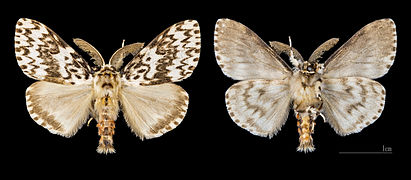You are here
Species
Lymantria monacha (Linnaeus)
IUCN
NCBI
EOL Text
Barcode of Life Data Systems (BOLDS) Stats
Public Records: 35
Specimens with Barcodes: 79
Species With Barcodes: 1
United States
Rounded National Status Rank: NNA - Not Applicable
| License | http://creativecommons.org/licenses/by-nc/3.0/ |
| Rights holder/Author | NatureServe |
| Source | http://explorer.natureserve.org/servlet/NatureServe?searchName=Lymantria+monacha |
Rounded Global Status Rank: GNR - Not Yet Ranked
| License | http://creativecommons.org/licenses/by-nc/3.0/ |
| Rights holder/Author | NatureServe |
| Source | http://explorer.natureserve.org/servlet/NatureServe?searchName=Lymantria+monacha |
|
|
This article may be expanded with text translated from the corresponding article in the Finnish Wikipedia. (December 2013) Click [show] on the right to read important instructions before translating.
|
The black arches or nun moth (Lymantria monacha)[1] is a small Palaearctic moth. It is considered a forest pest. [2]
Contents
Description[edit]
The moth has white forewings with black connected wavy arches which gives the moth its name. The light brown hindwings have white fringes having black spots. Female is larger and has elongated wings. The moth also has a characteristic biscuit-coloured abdomen with a black band. The moth has a wingspan of 4 to 5 cm.[1]
Technical description and variation[edit]
- See glossary for terms used
White forewing with black basal spots and four sharply angulate black transverse lines, the second of which is the broadest; hindwing greyish white and grey. Abdomen light rosepink. The species varies strongly and has received the following aberrational names, nigra Fr. : The two central bands are confluent at the costal and posterior margins, forming black spots, or the whole median area is dark, the red of the abdomen usually weaker, eremita G. : Forewing and abdomen smoke-brown or blackish grey, the former with black markings, atra Linst.: Forewing uniformly black, without markings, hindwing greyish brown,adomen black, lutea Anel is a light form in which the central bands are interrupted; the red colour of the ab domen is equally deep almost to the thorax, flavoabdominalis Schultz has the abdomen yellow instead of red; subfusca Schultz female is distinguished by everything which is black in true monacha being yellowish brown, and the abdomen being also yellowish brown instead of red; in obsoleta Schultz the dark transverse bands in the median area of the forewing are absent, while they remain in the basal and outer-marginal areas. All these names were given to European specimens. [3]
Range[edit]
Europe including British Isles. Temperate regions of the Palearctic East to Japan.[1]
Life cycle[edit]
The egg is oval, light brown or light red. The larvae hibernate when young, remain together in batches and are fullgrown in June. They are then whitish grey to blackish, with grey hairs, red and blue warts, and a dark longitudinal dorsal line which is interrupted or broadened into spots in places. Pupa golden glossy red-brown or dark brown, with reddish hairs dorsally and rather long anal point.
Foodplants and pest significance[edit]
The larvae feed preferentially on spruce (Picea abies) and pine (Pinus sylvestris). They also feed on silver fir (Abies alba), European larch (Larix decidua), aspen (Populus tremula), hornbeam (Carpinus betulus), European beech (Fagus sylvatica), pedunculate oak (Quercus robur), apple (Malus domestica), sycamore maple (Acer pseudoplatanus), bilberry (Vaccinium myrtillus) and bogberry (Vaccinium uliginosum). In spring the larvae consume the first buds, then later the needles. A single caterpillar eats about 200 pine, or 1000 spruce needles and twice as many are damaged by biting off. Spruces die at 70 percent needle loss and pine at 90 percent. There is also a danger also increased of secondary infections by longhorn beetles, bark beetles, fungi or other pathogens. Therefore, outbreaks can cause major damage in forestry.[4]
Gallery[edit]
See also[edit]
Notes[edit]
- ^ a b c Carter, David. Butterflies and Moths, Dorling Kindersley, pg 271
- ^ Canadian Food Inspection Agency Factsheet
- ^ Seitz, A. Ed. Die Großschmetterlinge der Erde, Verlag Alfred Kernen, Stuttgart Band 2: Abt. 1, Die Großschmetterlinge des palaearktischen Faunengebietes, Die palaearktischen Spinner und Schwärmer, 1912- 1913
- ^ Bugwood Wiki
References[edit]
- Carter, David (1992) Butterflies and Moths. Dorling Kindersley Handbooks, London. ISBN 0-7513-2707-7.
| License | http://creativecommons.org/licenses/by-sa/3.0/ |
| Rights holder/Author | Wikipedia |
| Source | http://en.wikipedia.org/w/index.php?title=Black_Arches&oldid=643661539 |
United States
Origin: Exotic
Regularity: Regularly occurring
Currently: Present
Confidence: Confident
Type of Residency: Year-round
| License | http://creativecommons.org/licenses/by-nc/3.0/ |
| Rights holder/Author | NatureServe |
| Source | http://explorer.natureserve.org/servlet/NatureServe?searchName=Lymantria+monacha |
Animal / parasitoid / endoparasitoid
larva of Carcelia puberula is endoparasitoid of larva of Lymantria monacha
Animal / parasitoid / endoparasitoid
larva of Lydella stabulans is endoparasitoid of larva of Lymantria monacha
Animal / parasitoid / endoparasitoid
larva of Parasetigena silvestris is endoparasitoid of larva of Lymantria monacha
Animal / parasite / endoparasite
larva of Sarcophaga aratrix endoparasitises Lymantria monacha
Animal / parasite / endoparasite
larva of Sarcophaga caerulescens endoparasitises Lymantria monacha
The following is a representative barcode sequence, the centroid of all available sequences for this species.
There are 63 barcode sequences available from BOLD and GenBank.
Below is a sequence of the barcode region Cytochrome oxidase subunit 1 (COI or COX1) from a member of the species.
See the BOLD taxonomy browser for more complete information about this specimen and other sequences.
-- end --





